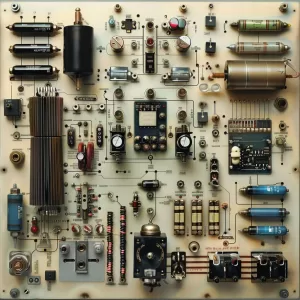
Exploring the Basics of Rectifier Circuits
April 28 2024 
Inquiry
Global electronic component supplier AMPHEO PTY LTD: Rich inventory for one-stop shopping. Inquire easily, and receive fast, customized solutions and quotes.
QUICK RFQ
ADD TO RFQ LIST
In this blog, we will delve into the world of Rectifier Circuits, explaining their function, operation, design considerations, and applications.
What is Rectifier Circuit?

Types of Rectifier Circuits
Here's a breakdown of the most common rectifier types:- Half-Wave Rectifier: This is the most basic type of rectifier, utilizing a single diode. The diode permits the positive half of the AC waveform to flow through, but the negative half is blocked. The resulting output is a pulsing DC waveform that contains only half of the original AC signal.
- Full-Wave Rectifier Bridge Rectifier: This kind uses four diodes connected in a bridge design. It makes use of both halves of the AC waveform, successfully transforming positive and negative cycles into pulsing DC. This leads to a more efficient utilization of AC power and a greater average DC output voltage than a half-wave rectifier.
- Bridge Rectifier with Capacitor Filter: This circuit builds on the full-wave bridge rectifier and includes a capacitor. The capacitor functions as a temporary storage reservoir, charging during the peaks of the pulsing DC waveform and discharging energy during the valleys. This helps to smooth out the pulsing DC and produces a more steady output voltage.
What Does a Rectifier Circuit Do?
Rectifier circuits serve an important part in many electrical applications. Here are some important functions they perform:- Power Supply Conversion: Most electronic devices require direct current (DC) to function. Rectifiers transform incoming AC from the wall socket into pulsating DC voltage, which is the initial step in powering your gadgets.
- Signal Processing: In some electronic circuits, rectifiers are used to extract specific components of an alternating current signal, such as the average value from the oscillating component.
- Battery Charging: Rectifiers are used in battery chargers to convert alternating current (AC) power into direct current (DC), which is then utilized to charge batteries in portable electronic devices.
Video related to Rectifier Circuit
How Rectifier Circuit Works?
There are several types of rectifier circuits, each of which uses different components to produce rectification. Here, we'll look at two popular types:- Half-Wave Rectifier: This simple circuit makes use of a single diode, which acts as a one-way electrical valve. During the positive half of the AC waveform, the diode allows current to flow through the circuit. However, the diode's reverse bias blocks the negative half cycle, blocking current flow in that direction. While successful, this design produces a pulsing DC output and wastes energy during the blocked half cycle.
- Full-Wave Rectifier: This more efficient version uses four diodes placed in a bridge arrangement, hence the name "bridge rectifier." This is how it works.
- During the AC waveform's positive half-cycle, current flows through one pair of diodes in the bridge, allowing positive voltage to pass through.
- During the negative half cycle, the opposite pair of diodes conduct, allowing current to flow in the same direction throughout the circuit. This produces a pulsing DC output with substantially less wasted energy than the half-wave rectifier.
How to Make Rectifier Circuit?
Here's a simplified example of constructing a half-wave rectifier with a diode and resistor: Components:- Breadboard
- 9V Battery
- 1N4001 Diode (or similar general-purpose diode)
- 220 Ohm Resistor
- LED
- Jumper Wires
- Connect the battery's positive terminal to one end of the breadboard.
- Connect the battery's negative terminal to another position on the breadboard.
- Insert the diode onto the breadboard, ensuring that the banded side faces the negative terminal.
- Connect one of the resistor legs to the battery's positive terminal.
- Connect the resistor's opposite leg to the side of the diode marked with the colored band.
- Connect the LED's positive leg (the longer leg) to the same position as the resistor connected to the diode.
- Connect the LED's negative leg to the negative terminal of the battery.
- Connect jumper wires to various spots on the circuit for testing and voltage monitoring.
How to Design Rectifier Circuit?
Here's a quick rundown on designing a rectifier circuit:- Define your needs: Input/output voltage and current, with an acceptable ripple level.
- Choose the rectifier type: Half-wave (low power), full-wave with center tap transformer (more efficient), and bridge rectifier (the most used).
- Select diodes: Consider the forward current rating, peak reverse voltage, and leakage current (Schottky diodes provide lesser leakage).
- Filtering (optional): Capacitors for smoothing DC voltage (change the capacitance to reduce ripple).
- Schematic and Layout: Create a circuit schematic and plan the actual layout on a PCB or veroboard.
Which Rectifier Circuit is Suitable for High Voltage?
A full-wave bridge rectifier is typically the best choice for high-voltage applications. Here's why:- Efficiency: Bridge rectifiers use both sides of the AC waveform, resulting in less wasted energy than half-wave rectifiers. This becomes especially important when working with high voltage, where limiting power loss is critical.
- Higher Output Voltage: Bridge rectifiers generate a greater average DC output voltage than half-wave rectifiers because they can use both the positive and negative portions of the AC waveform.
- Voltage Rating: Diodes used in high-voltage rectifier circuits must have sufficient voltage ratings to resist the incoming AC voltage. Bridge rectifiers frequently come pre-loaded with diodes rated for specific high-voltage applications.
Why Use Rectifier Circuit?
Rectifier circuits provide significant benefits in various electronic applications:- Power Conversion: As previously stated, rectifiers are required to convert AC power from wall outlets into DC power that can be used by most electronic equipment.
- Simplicity: Basic rectifier circuits, such as half-wave rectifiers, can be designed and built using a small number of components.
- Efficiency: Full-wave bridge rectifiers are more efficient than half-wave rectifiers, reducing waste energy during the rectification process.
- Versatility: Rectifiers can be used in a variety of electronic circuits, including power supplies, signal processing, and battery charging.
Applications of Rectifier Circuits
Rectifier circuits are the workhorses of innumerable electronic gadgets, providing essential power. Here are a few noteworthy examples:- Power Supplies: Rectifiers are the first stage in most power supplies, converting alternating current (AC) to pulsing direct current. This DC voltage is then processed and regulated to generate the voltages required by the device's electronic components.
- Battery Chargers: Many rechargeable batteries, such as those in your phone or laptop, are charged by rectification. A rectifier circuit converts the alternating current to direct current before feeding it to the battery for charge.
- Solar Power Systems: To be compatible with the power grid, the DC electricity generated by solar panels is generally converted to AC. Rectifiers are used in some grid-tied solar inverters to convert the DC output from solar panels to a specified voltage that the inverter can convert into AC for the grid.
Conclusion
Rectifier circuits serve as the foundation for using direct current to power modern electronic devices. Understanding their function, operation, and design concerns allows you to go deeper into the field of electronics. Whether you're a hobbyist working on a simple project or an ambitious engineer creating sophisticated circuits, rectifiers are essential for converting alternating current power into direct current, the lifeblood of modern electronics. What is Rectifier CircuitTypes of Rectifier CircuitsWhat Does a Rectifier Circuit DoVideo related to Rectifier CircuitHow Rectifier Circuit WorksHow to Make Rectifier CircuitHow to Design Rectifier CircuitWhich Rectifier Circuit is Suitable for High VoltageWhy Use Rectifier CircuitApplications of Rectifier CircuitsConclusion
Related Articles
- ·Stratix 10 VS Stratix V: Which FPGA is Right for Your Next Project?
- ·Intel Xeon Platinum 8454H vs AMD EPYC: Which Reigns Supreme?
- ·A Deep Dive into the AMD EPYC 4564P Processor
- ·MSP430F5438A vs MSP430F5529: A Detailed Analysis of Their Capabilities
- ·Comparing MSP430F6659 and MSP430F5419A: Which One is Right for Your Project?
- ·Exploring the Features of MSP430F5529 and MSP430F5638 Microcontrollers
- ·Demystifying 20 Microcontroller Projects for Beginners
- ·Unveiling the Ultimate Guide to Microcontroller Programming
- ·4680 Battery: Unveiling the Power Potential of the Next-Gen Cell
- ·Exploring the Case Studies on Arduino Applications
Populer Posts
ADSP-SC570BSWZ-42
Analog Devices Inc.
MSC8156ETVT1000B
Freescale Semiconductor, Inc. (NXP Semiconductors)
SAF7751HV/N205/SCK
NXP Semiconductors
SAF775DHN/N208W/BK
NXP Semiconductors
ADSP-BF547BBCZ-5A
Analog Devices Inc.
TMS320C6727GDHA250
Texas Instruments
DSPIC33CDVC128MP506T-E/M9
Microchip Technology
TMS320C5532AZAYA10
Texas Instruments
TMS320C6416TBCLZA7
Texas Instruments
SAF4000EL/101S53DK
NXP Semiconductors
SAF7770EL/101Z120Y
NXP Semiconductors
SAF7751HV/N207W/BK
NXP Semiconductors
